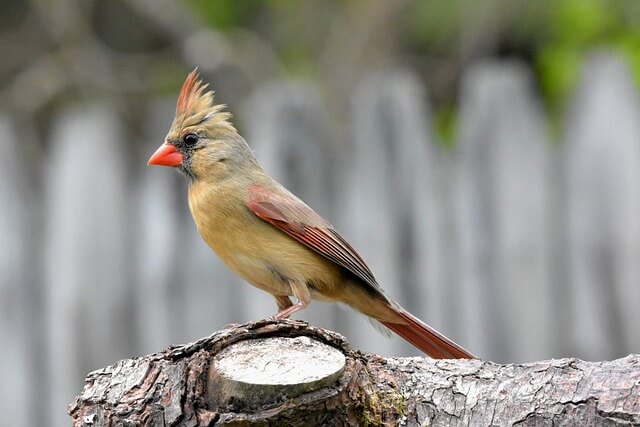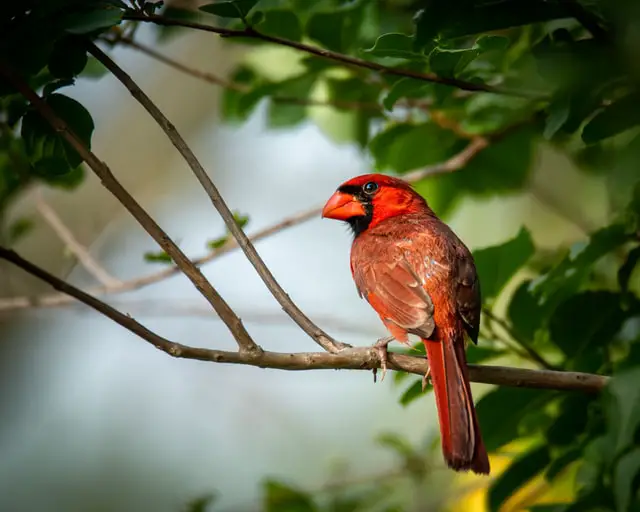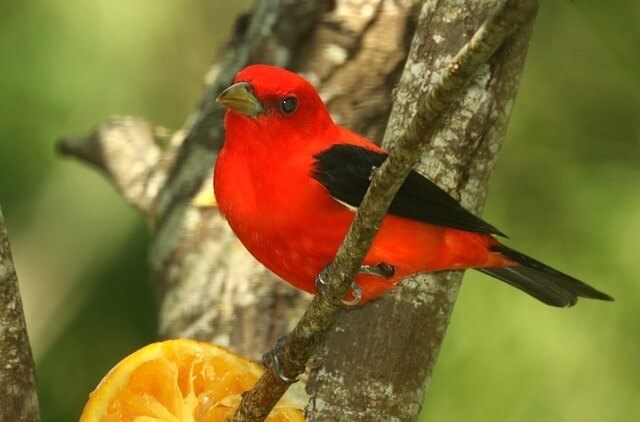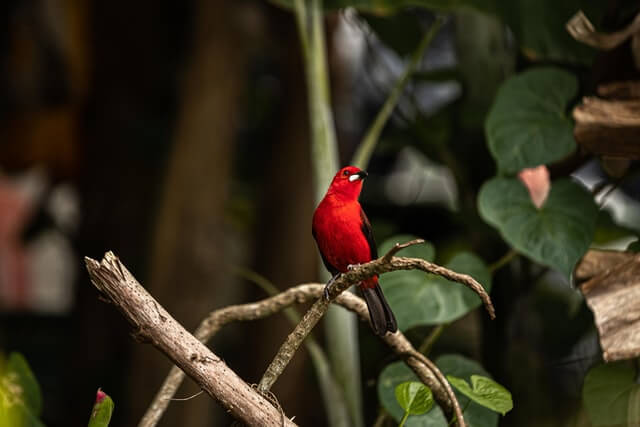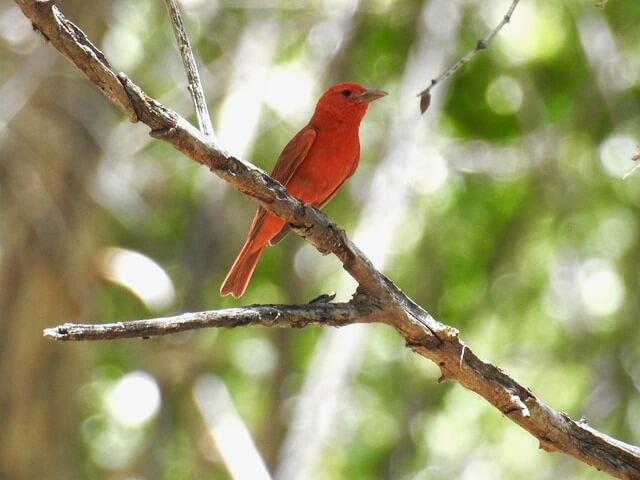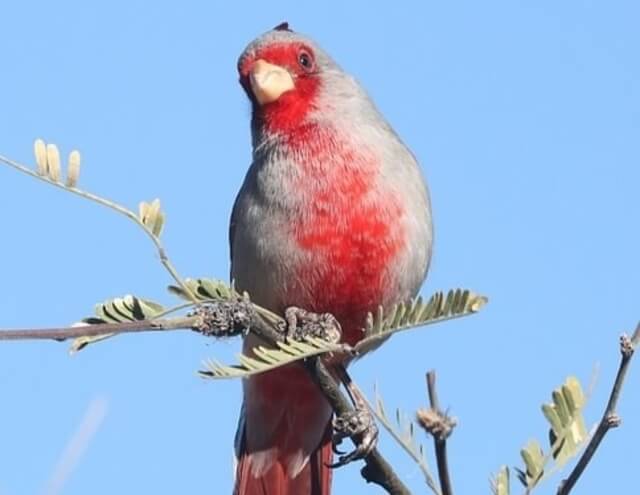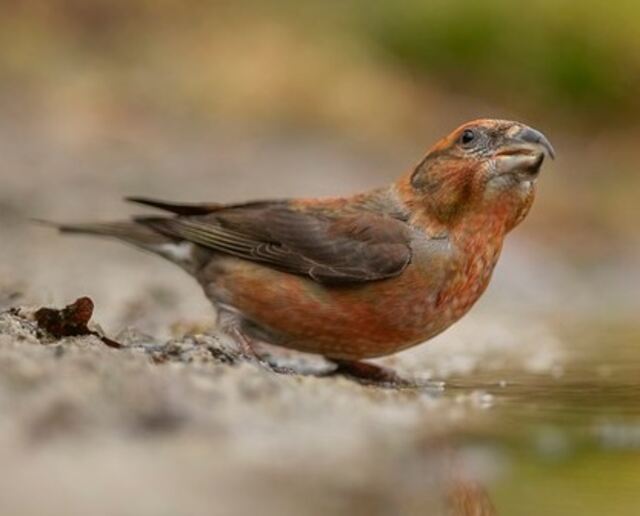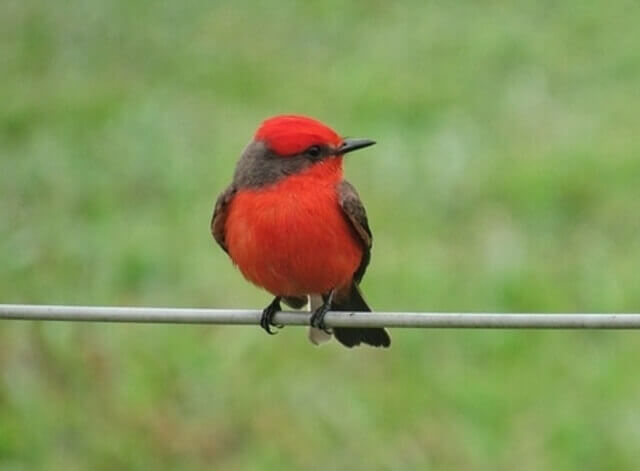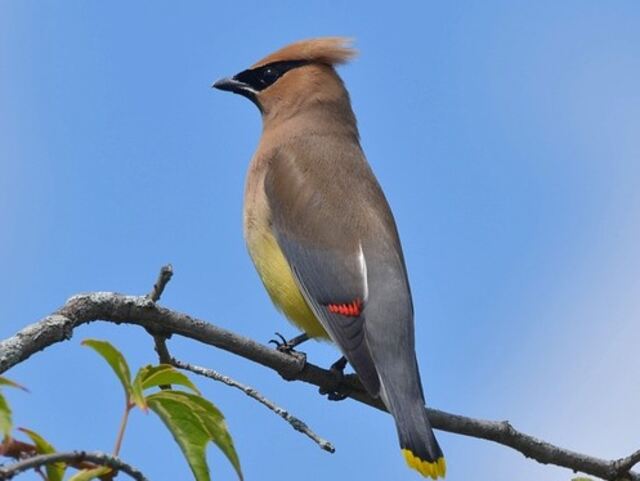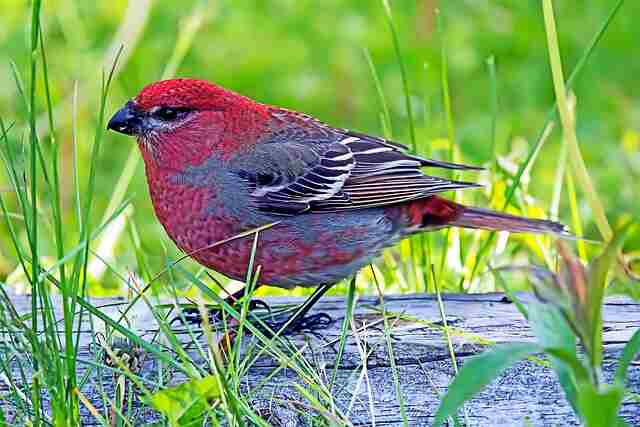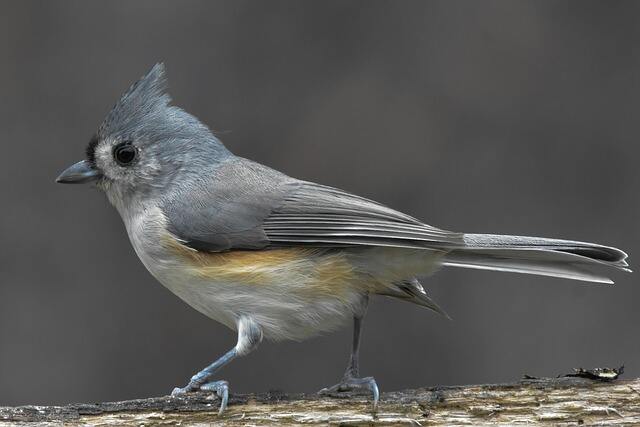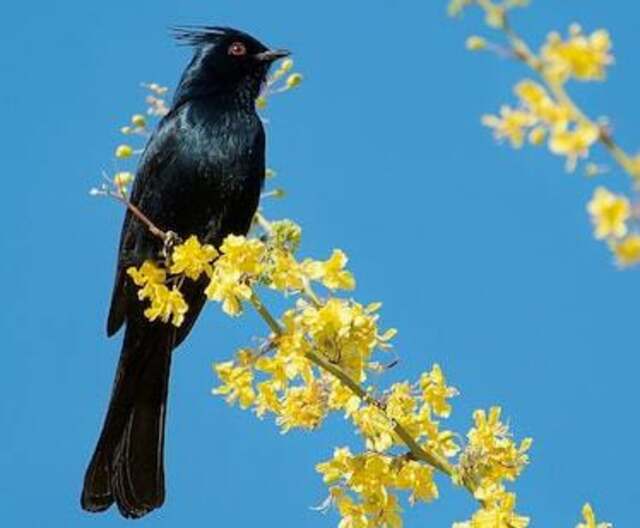Cardinals are among the most widespread backyard birds in North America. They are easily recognized by their bright red plumage, but did you know that there are other birds that look like cardinals?
In this complete guide, we will show you 17 birds that look like cardinals, with photos and identification tips. You will also learn about their habitat, diet, songs and calls.
Table of Contents
- 1 Northern Cardinal (Overview)
- 2 Quick Reference Guide
- 3 Birds That Look Like Cardinals
- 3.1 Vermilion Cardinal
- 3.2 Summer Tanager
- 3.3 Scarlet Tanager
- 3.4 Flame-colored Tanager
- 3.5 Hepatic Tanager
- 3.6 Pyrrhuloxia
- 3.7 Red Crossbill
- 3.8 Common Rosefinch
- 3.9 Red-billed Firefinch
- 3.10 Vermilion Flycatcher
- 3.11 California Towhee
- 3.12 Cedar Waxwing
- 3.13 House Finch
- 3.14 Pine Grosbeak
- 3.15 Purple Finch
- 3.16 Tufted Titmouse
- 3.17 Phainopepla
- 4 Author
Northern Cardinal (Overview)
The Northern Cardinal (Cardinalis cardinalis) is a common bird species found throughout North America. The males are well-known for their bright red plumage and distinctive crest, while the females are more muted in color, with reddish-brown feathers and a crest that is less prominent. Here’s a closer look at some of the key characteristics, distribution, habitat, diet, and similarities and differences with other birds.
Characteristics
The Northern Cardinal is a medium-sized bird, measuring around 8-9 inches in length and weighing around 1-1.5 ounces. The males have a bright red body, black face, and distinctive crest, while the females have a reddish-brown body, gray face, and crest that is less prominent. Both males and females have a thick, cone-shaped bill that is well-suited for cracking open seeds and nuts.
Distribution Range
The Northern Cardinal is found throughout North America, from southern Canada to Mexico. It is most commonly found in wooded areas, parks, and suburban areas, and is a popular backyard bird.
Habitat
The Northern Cardinal is most commonly found in wooded areas, where it prefers to nest and forage for food. It is also commonly found in parks, gardens, and suburban areas, where it can feed on bird feeders and other food sources.
Diet
The Northern Cardinal is primarily a seed-eater, feeding on a wide variety of seeds and nuts. It also eats insects, fruit, and other small animals. In urban and suburban areas, it is common to see Northern Cardinals feeding on bird feeders filled with seeds and nuts.
Quick Reference Guide
| Bird Type | Size | Coloration | Range | Behaviors |
|---|---|---|---|---|
| California Towhee | 8-9 inches | Gray-brown overall with rusty sides and undertail | West Coast of North America, from Oregon to Baja California | Scratches for food on the ground, often flicks its tail |
| Cedar Waxwing | 6-7 inches | Brown-gray overall with a black mask and crest | Throughout North America, in wooded habitats | Often seen in flocks, with a high-pitched, buzzing call |
| Flame-Colored Tanager | 6.5-7.5 inches | Bright orange-red overall | Mountains of western North America | Hops along branches and twigs while foraging for insects |
| Hepatic Tanager | 7-8 inches | Dark red overall with a black tail and wings | Western North America, from the Rockies to Mexico | Often perches motionless for long periods of time, feeds on fruits and insects |
| House Finch | 5-6 inches | Brown overall with streaks of red or yellow | Throughout North America, in suburban areas | Often feeds on the ground, with a musical song |
| Phainopepla | 7-8 inches | Glossy black overall with white wing patches | Southwestern United States and Mexico | Perches motionless for long periods of time, feeds on mistletoe berries |
| Pine Grosbeak | 8-10 inches | Red overall with black wings and tail | Northern North America, in coniferous forests | Often seen in flocks, feeds on seeds and insects |
| Purple Finch | 4.7-6 inches | Raspberry-red overall with brown streaks | Across North America, in forests and suburbs | Often seen at bird feeders, with a lively song |
| Pyrrhuloxia | 7-8 inches | Gray overall with a red mask and crest | Southwestern United States and Mexico | Feeds on seeds and insects, with a sharp, metallic call |
| Red-Billed Firefinch | 4-4.5 inches | Bright red overall with a black tail | Sub-Saharan Africa, in scrub and savannah habitats | Often seen in flocks, with a high-pitched, trilling call |
| Red Crossbill | 5-6 inches | Red overall with a crossed bill | Across North America, in coniferous forests | Uses its bill to extract seeds from cones, often seen in small flocks |
| Common Rose Finch | 5.5-6 inches | Pinkish-red overall with white wing patches | Central Asia and Europe, in open habitats | Often seen in flocks, feeds on seeds and insects |
| Scarlet Tanager | 7-7.5 inches | Bright red overall with black wings and tail | Eastern United States, in forests and woodlands | Often seen high in trees, feeds on insects |
| Summer Tanager | 6.5-7.5 inches | Bright red overall with black wings and tail | Southern United States and Central America, in forests | Often seen foraging in the canopy, with a distinctive “pik-a-tuk” call |
| Tufted Titmouse | 6-6.5 inches | Gray overall with a distinctive crest and black patch above the bill | Eastern United States, in forests | Often seen at bird feeders, with a whistled song and acrobatic movements |
| Vermilion Flycatcher | 4-5 inches | Bright red overall with a gray head and wings | Southwestern United States and Mexico | Perches on exposed branches, feeds on insects and small vertebrates |
| Female Northern Cardinal | 7.5 inches | Brownish overall with a distinctive crest and red accents | Across the eastern and central United States, in wooded habitats | Often seen at bird feeders, with a distinctive “chip” call and a preference for seeds and fruits |
| Vermilion Cardinal | 7-7.5 inches | Bright red overall with a distinctive crest | Northern South America, in forests and woodlands | Often perches high in trees, feeds on fruits and insects |
Birds That Look Like Cardinals
Vermilion Cardinal
Vermilion Cardinals are small birds with bright red feathers and distinctive crests on their heads. These birds can be found in the southern region of the United States, as well as in Central America and the northern regions of South America. Their habitats include forests, woodlands, and brushy areas with thick vegetation.
Vermilion Cardinals mainly feed on seeds, fruits, and insects. Their vibrant coloration and unique song make them a popular sight for birdwatchers. In comparison to the Vermilion Cardinal, Northern Cardinals have a larger range, spanning across most of North America.
They prefer woodland areas with dense shrubs and feed on seeds, fruits, and insects, much like the Vermilion Cardinal. The males have bright red feathers, while the females have a brownish-red color.
Unlike Vermilion Cardinals, Northern Cardinals do not have crests on their heads. They are also slightly larger and have a more melodic song. However, both species share similarities in their habitat preferences and diet.
- Length: 4.7-9.8 in. (11.9-24.9 cm)
- Weight: 0.8-1.5 oz.
- Wingspan: 9-11 in. (22.9-27.9 cm)
- Maps: Range Map
- Sounds: Calls and Songs
Summer Tanager
The Summer Tanager is a striking bird with a stocky body and a thick, pointed bill. The males have bright red plumage, while females are yellow-green. They are found in the southern United States, Mexico, Central America, and Northern South America, and prefer open woodlands and forest edges. Their diet consists mainly of insects and fruit, and they catch their prey while perched or in flight.
The Northern Cardinal and Summer Tanager are both colorful songbirds, but they differ in many ways. While both species can be found in the southern United States, the Northern Cardinal has a much larger range that extends into Canada and Mexico.
Cardinals also prefer habitats with dense vegetation, while Tanagers prefer open woodlands. They have a varied diet that includes seeds and insects, while Tanagers primarily eat insects and fruit. Cardinals are slightly larger than Tanagers, and males have a bright red plumage while females are brownish-red.
Meanwhile, Tanager males are entirely red and females are yellow-green. Finally, Cardinals are known for their distinctive songs, while Tanagers have a more simple and monotonous call.
- Length: 7.1-8.0 in. (18-20 cm)
- Weight: 28 g (1 oz)
- Wingspan: 11.0-11.8 (28-30 cm)
- Maps: Range Map – Sightings Map
- Sounds: Calls and Songs
Scarlet Tanager
The Scarlet Tanager is a brightly colored bird with a black wings and tail, and a brilliant red body. They are mainly found in deciduous forests in eastern North America during the breeding season. During winter, they undertake migration to South America.
Their diet primarily consists of insects, fruits, and seeds, and they can often be seen foraging in the treetops. The Northern Cardinal is another popular bird species in North America. They are slightly larger than the Scarlet Tanager, and have a distinctive crest on their head.
They are also known for their bright red plumage, but unlike the Tanager, the Cardinal has a reddish-orange beak. Not only that, but they are found throughout North America in a variety of habitats such as forests, parks, and suburban areas.
Their diet consists of seeds, fruits, and insects, and they are often seen at bird feeders. Unlike the Tanager, Cardinals do not migrate, and can be seen year-round.
- Length: 6.3-7.1 in (16-18 cm)
- Weight: 0.8-1.3 oz (22-38 g)
- Wingspan: 9.8-11.8 in (25-30 cm)
- Maps: Range Map – Sightings Map
- Sounds: Calls and Songs
Read more: How to Attract Scarlet Tanagers to your Yard?
Flame-colored Tanager
Flame-colored Tanagers are known for their bright and striking plumage, featuring a deep red-orange body with black wings and tail. These birds are found in the tropical forests of Central and South America, ranging from southern Mexico to Bolivia.
They typically inhabit the canopy and mid-levels of the forest, feeding on a diet of fruit, insects, and nectar. In contrast, Northern Cardinals are found throughout much of North America, from southern Canada to Mexico.
They prefer habitats with dense shrubbery and trees, such as woodlands, gardens, and parks. While they also have a diet that includes fruit, insects, and seeds, they are known for their love of sunflower seeds and other birdseed offerings.
Cardinals have a distinctive crest on their head and are known for their bright red coloration on the males, while females have a more muted brownish-red coloration.
They are also slightly larger than Flame-colored Tanagers and have a more robust beak for cracking open seeds. Both species are known for their beautiful singing voices, but their behaviors and habitats differ greatly.
- Length: 6.7-7.3 in (17-18 cm)
- Weight: 33 g (1.2 oz)
- Wingspan: 12-12.5″ in. (30.5-31.8 cm)
- Maps: Range Map
- Sounds: Calls and Songs
Hepatic Tanager
The Hepatic Tanager is a striking bird with a stocky body, thick bill, and bright red plumage on the male’s head and body. Their range extends from the southwestern United States to Central and South America, where they inhabit coniferous and mixed forests. They feed on a diet that includes insects, fruits, and seeds.
In terms of similarities, both the Hepatic Tanager and Northern Cardinal are songbirds found in North America, with the latter being more widely distributed. They share a similar diet, feeding on insects, fruits, and seeds.
However, the Northern Cardinal is larger, with a longer tail and crest. Males of both species have bright plumage, but the Cardinal’s is a deep red, while the Hepatic Tanager’s is a brighter, orange-red.
Cardinals prefer woodland edges, backyards, and gardens, while Tanagers prefer higher elevations in forests. Finally, the Cardinal has a more varied vocalization, while the Tanager’s song is simpler and more repetitive.
- Length: 5.9-6.7 in (15-17 cm)
- Weight: 0.8-1.3 oz (22-38 g)
- Wingspan: 10.2-11.4 in (26-29 cm)
- Maps: Range Map – Sightings Map
- Sounds: Calls and Songs
Pyrrhuloxia
Pyrrhuloxias are essentially desert-dwelling cardinals, found in brushy areas of the southwestern U.S. and northern Mexico. They have a similar shape to Northern Cardinals, but with a longer, thinner crest and more rounded bill shape.
The majority of their feathers are gray, with notable red accents on their face, crest, belly, wings, and tail. The bill color is typically yellowish, but grayer on immature birds. Pyrrhuloxias are usually seen in pairs or small flocks, and they often visit bird feeders.
Their song is similar to the Northern Cardinal, but higher-pitched and more piercing. When comparing Pyrrhuloxias to Northern Cardinals, there are some similarities and differences. Both species inhabit similar habitats such as woodlands, scrublands, and deserts, and primarily feed on seeds and insects.
However, Pyrrhuloxias have a more restricted range than Northern Cardinals, and they are typically found in more arid regions. Additionally, Pyrrhuloxias have a more muted coloration, with their red highlights being less bright than the Northern Cardinal’s.
They also have a higher-pitched and more piercing song than the Northern Cardinal. Despite these differences, both species are beloved by birdwatchers and appreciated for their beauty and unique characteristics.
- Length: 8.0-8.75 in (20-22 cm)
- Weight: 37 g (1.3 oz)
- Wingspan: 12-12.5″ in. (30.5 cm-31.8)
- Maps: Range Map – Sightings Map
- Sounds: Calls and Songs
Red Crossbill
Red Crossbills are small, chunky finches with short, thick bills that are crossed at the tips. Their unique beaks allow them to extract seeds from the cones of various coniferous trees. They have a wide range across North America, and their preferred habitats include forests, woodlands, and mountainous areas.
Red Crossbills are known for their nomadic behavior, often traveling long distances in search of food. In contrast, Northern Cardinals are larger birds known for their brilliant red plumage on males and brownish-gray feathers on females.
They are found primarily in eastern and central North America, inhabiting wooded areas, gardens, and parks. Their diet consists of seeds, insects, and fruit. Northern Cardinals are non-migratory and can be spotted year-round in their range.
Unlike Red Crossbills, they do not have crossed bills and do not rely on coniferous cones for food. However, both species have a strong association with coniferous forests and may overlap in their ranges.
- Length: 7.5-7.9 in.(19-20 cm)
- Weight: 1.4-1.9 oz. 40-53 g
- Wingspan: 10.6-11.4 in. (27–29 cm)
- Maps: Range Map – Sightings Map
- Sounds: Calls and Songs
Common Rosefinch
Fiery red and bursting with melody, the Common Rosefinch is a small finch known for its sweet voice and colorful plumage. Found across Asia, Europe, and North Africa, this bird thrives in various habitats from forests to meadows. The male’s vibrant red head, breast, and rump set it apart while the female is comparatively subdued.
With an omnivorous diet of seeds, berries, and insects, the Common Rosefinch is a resourceful feeder.
Differences abound between the Northern Cardinal and the Common Rosefinch, but similarities are not to be overlooked.
The Northern Cardinal, a finch native to North and Central America, boasts a distinctive bright red hue, while the male Common Rosefinch sports a red head, breast, and rump. Both birds occupy forests and grasslands and sing sweetly.
Their diet consists of seeds, fruits, and insects. The Northern Cardinal, slightly larger than the Common Rosefinch, is known for its aggressive behavior during breeding season.
- Length: 5.4-5.9 in. (13.7–15 cm)
- Weight: 0.74-0.92 oz. (21–26 g)
- Wingspan: 8.5-9.0″ in. (21.6-22.9 cm)
- Maps: Range Map
- Sounds: Calls and Songs
Red-billed Firefinch
Red-billed Firefinches are small, brightly colored birds found in sub-Saharan Africa. They have a distinctive red bill and plumage that ranges from red to brown, with black streaks on their wings and back. These birds prefer grasslands, savannas, and scrublands for their habitat, and they primarily feed on seeds and insects.
In comparison, Northern Cardinals are found throughout North America, primarily in the eastern United States. They are known for their distinctive red crest and plumage, with males having a bright red coloration and females having a more muted brownish-red color.
Cardinals prefer woodland edges and suburban areas, and they feed primarily on seeds and fruits. Unlike Firefinches, Cardinals are larger and have a distinctive crest on their head. Both birds have similar feeding habits and behaviors, but they differ in appearance and range.
- Length: 3.5-4.0″ in. (9-10 cm)
- Weight: 0.25-0.42 oz. (7-12 g)
- Wingspan: 4.9-5.5″ in. (12.5-14 cm)
- Maps: Range Map
- Sounds: Calls and Songs
Vermilion Flycatcher
The Vermilion Flycatcher is a small, colorful bird found in the Americas. With its bright red plumage, black mask, and crest, it is easily recognizable. It is a year-round resident in the southwestern United States, Mexico, and Central and South America. The bird prefers open habitats such as grasslands, savannas, and wetlands. Its diet mainly consists of insects such as flies, bees, and wasps, which it catches while flying.
In contrast, the Northern Cardinal is a larger bird with a distinctive red crest and a black face mask in males. They are found in North America and prefer woodland habitats, as well as residential areas with bird feeders.
Their diet includes seeds, fruits, and insects. Unlike the Vermilion Flycatcher, Cardinals are not as agile in flight and often prefer perching on branches or feeders. While both birds are known for their vibrant red coloring, Cardinals also have a gray beak, while the Vermilion Flycatcher has a black beak.
Additionally, Cardinals are known for their loud, distinctive song, while the Flycatcher’s vocalizations are more subdued.
- Length: 5.0–5.5 in (12.7–14 cm)
- Weight: 0.4–0.5 oz (11–14 g)
- Wingspan: 9.4-9.8″ in. (24-25 cm)
- Maps: Range Map – Sightings Map
- Sounds: Calls and Songs
California Towhee
The California Towhee, a medium-sized sparrow, is a common bird found in the western United States. It is known for its distinctive “chink” call and its preference for staying close to the ground. Its brownish-gray plumage and reddish-brown eyes are key identifying features.
The bird thrives in a range of habitats, from chaparral to suburban areas. The California Towhee’s diet includes seeds, insects, and fruits. While the California Towhee and the Northern Cardinal share some similarities, they also have many differences.
The Northern Cardinal is a bit larger and is more brightly colored, with the male having a striking red crest and body. Unlike the California Towhee, the Northern Cardinal is a year-round resident in the eastern United States. Its preferred habitat is woodlands and suburban areas.
The Northern Cardinal’s diet includes seeds, fruits, and insects. Additionally, while both birds are known for their distinctive calls, the Northern Cardinal’s song is more complex and melodic than the California Towhee’s simple “chink” call.
- Length: 8.3-9.8 in (21-25 cm)
- Weight: 1.3-2.4 oz (37-67 g)
- Wingspan: 11.4 in (29 cm)
Read more: How to Attract Towhee to your Backyard? Expert Tips!
Cedar Waxwing
The Cedar Waxwing is a small, colorful bird with a distinctive crest on its head. Found across North America, it inhabits open woodlands, orchards, and gardens, and feeds primarily on fruit, but also eats insects in the breeding season.
The Waxwing’s unique appearance, with its masked eyes and bright red tips on its wings, make it a popular sight among birdwatchers. The Northern Cardinal is another common bird species found across North America, but is larger and more robust than the Cedar Waxwing.
While both species inhabit woodlands and gardens, the Cardinal tends to prefer denser vegetation. Unlike the Waxwing, the Cardinal is primarily a seed-eater, but will also eat fruit and insects.
Male Cardinals are known for their bright red plumage, while females are a duller brown color. Both species are known for their distinctive calls and are a delight to watch in any backyard bird feeder.
- Length: 5.5-6.7 in (14-17 cm)
- Weight: 1.1 oz (32 g)
- Wingspan: 8.7-11.8 in (22-30 cm)
Read more: How to Attract Cedar Waxwings to your Yard (Experts Tips)
House Finch
House Finches are small, active birds with a distinctive red plumage on males’ heads and breasts. They are native to North America and can be found throughout the United States, Mexico, and Canada. They are commonly found in suburban areas and feed on a variety of seeds, fruits, and insects.
House Finches are also known for their melodious songs and are a popular sight in backyard bird feeders. Northern Cardinals, also native to North America, have a similar range as House Finches but prefer dense vegetation and woodland habitats.
They are slightly larger and have a more robust beak, which they use to crack open seeds and nuts. The males have a bright red plumage, while the females have a more muted brownish-red coloration.
Unlike House Finches, Northern Cardinals are monogamous and are known for their beautiful songs, which they use to communicate with their mate and defend their territory.
- Length: 5.1-5.5 in (13-14 cm)
- Weight: 0.6-0.9 oz (16-27 g)
- Wingspan: 7.9-9.8 in (20-25 cm)
Read more: How to Attract House Finch to your Yard? (Easy & Fast)
Pine Grosbeak
Pine Grosbeaks are stunning birds with a plump body, thick bill, and vibrant coloration. Bursting with a mix of pink, red, and gray plumage, they are found across northern regions of North America, Europe, and Asia.
These birds prefer coniferous forests, where they can forage for seeds, buds, and berries. Their diet also includes insects and, occasionally, small fruits. In contrast, Northern Cardinals are equally colorful birds, with a crest on their head and a distinctive red plumage on males.
These birds are found exclusively in North America, primarily in the eastern and southeastern regions. They prefer woodland edges, gardens, and parks.
Their diet includes seeds, fruits, insects, and occasionally, small vertebrates. Unlike Pine Grosbeaks, Northern Cardinals do not migrate, and the males are the only ones with the red plumage.
Length: 7.1-10.2″ in. (18-26 cm)
Weight: 1.8-2.8 oz. (51-79 g)
Wingspan: 12.0-13.0″ in (30.5-33.0 cm)
Purple Finch
The Purple Finch is a stunning bird species, characterized by its crimson head, breast, and rump, contrasted by a brown back, wings, and tail. They are medium-sized, measuring up to 6 inches in length, and are found throughout North America, from Alaska to Mexico.
Purple Finches inhabit various forest types, including deciduous, coniferous, and mixed forests, and can also be spotted in suburban areas with ample trees and shrubs. Their diet consists mainly of seeds, buds, and fruits, including those from alder, birch, pine, and fir trees.
In terms of similarities, both the Northern Cardinal and Purple Finch have a similar range, occupying North America. They also share a habitat preference for wooded areas and suburban gardens. However, while the Purple Finch is mainly a seed-eater, the Northern Cardinal is an omnivore, consuming seeds, fruits, insects, and small animals.
The Cardinal is also larger, measuring up to 8.5 inches, and is easily distinguished by its bright red plumage and distinctive crest. In contrast, the Purple Finch displays a more subdued coloration with a touch of rosy hue.
Additionally, Northern Cardinals are known for their unique vocalization, while Purple Finches have a more melodious and flute-like song. Overall, both species are fascinating birds with distinct characteristics that make them a joy to observe in the wild.
- Length: 4.7-6.3 in (12-16 cm)
- Weight: 0.6-1.1 oz (18-32 g)
- Wingspan: 8.7-10.2 in (22-26 cm)
Tufted Titmouse
Tufted Titmouse: small with a round head and a short, thick neck. They’re easily recognizable by their distinctive tuft of feathers on their head. Found throughout the eastern United States, from the Great Lakes region to the Gulf of Mexico. They prefer deciduous forests and woodland edges.
They’re opportunistic feeders, enjoying insects, seeds, and nuts, including caterpillars, beetles, and spiders, as well as sunflower seeds and peanuts from bird feeders. Northern Cardinal: larger bird than the Tufted Titmouse, with a crest on their head and a strong, thick beak.
They’re found in the eastern half of North America, from southern Canada to Mexico, and prefer dense shrubs and trees. Cardinals are often seen in backyards and gardens. They have a diet similar to that of the Tufted Titmouse, including insects, seeds, and fruits.
The male Cardinal has a bright red color, while the female is a duller brown. They’re known for their distinctive “chirp-chirp-chirp” call. The Tufted Titmouse, on the other hand, has a more raspy “peter-peter-peter” call.
- Length: 5.5-6.3 in (14-16 cm)
- Weight: 0.6-0.9 oz (18-26 g)
- Wingspan: 7.9-10.2 in (20-26 cm)
Read more: How to Attract Tufted Titmouse to my Yard? (Explained)
Phainopepla
Phainopeplas are striking birds with glossy black plumage and red eyes. They are found throughout the southwestern United States and Mexico in a range of habitats, including desert scrub, oak woodlands, and riparian areas.
These birds feed primarily on insects, including flies, bees, and wasps, and occasionally on fruits and berries. They are known for their distinctive vocalizations, including a whistling call and a series of clicks. Northern Cardinals are known for their bright red plumage and distinctive crest.
They are found throughout much of North America in a range of habitats, including forests, shrublands, and urban areas. Cardinals feed primarily on seeds and fruits, but also eat insects and other small animals. They are known for their sweet, clear whistle and for their habit of singing in the early morning and late afternoon.
Cardinals are larger than Phainopeplas and have a different overall shape, with a heavier body and shorter tail. While both species have striking plumage, the Cardinal’s red coloration is much more prominent than the Phainopepla’s subtle iridescence.
- Length: 7.1-8.3 in (18-21 cm)
- Weight: 0.6-1.0 oz (17.9-28.1 g)
- Wingspan: 10.6-11.4 in (27-29 cm)
Related Posts:
- Where Are Cardinals Found? Best Spots to Look!
- Best Birdhouse for Cardinals 2023: A Comprehensive Review
- 10 Best Bird Feeders for Cardinals 2023 (Ultimate Guide!)
Source: Information from the All About Birds website, www.allaboutbirds.org, © Cornell Lab of Ornithology.



